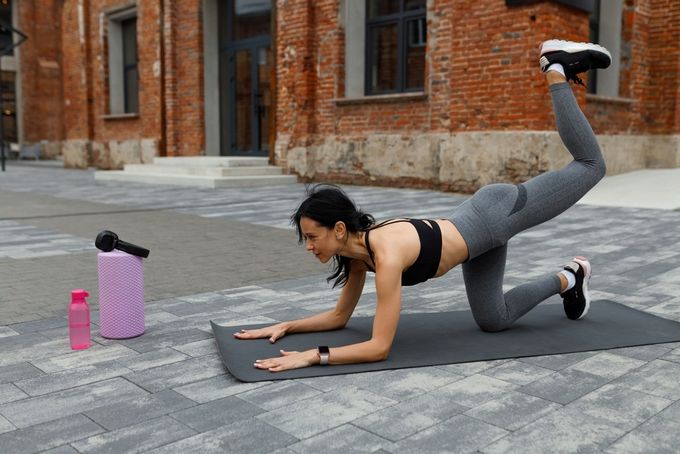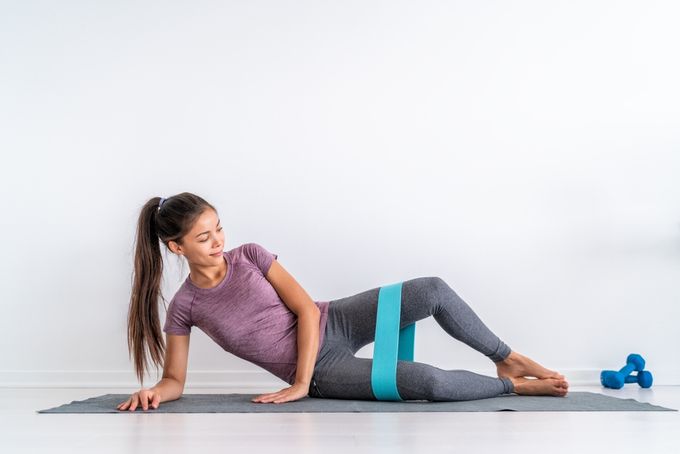Get Back on Track: 6 Strengthening Exercises for Runner's Knee
Updated January 25, 2024
Does your knee throb after a run? Is going downstairs a challenge due to persistent knee pain? You may be experiencing runner's knee, also known as patellofemoral pain syndrome (PFPS). PFPS, characterized by pain around or behind the kneecap, is often a result of overuse, muscle imbalances, weak thigh or hip muscles, or flat feet.
Its telltale symptoms include discomfort while walking downstairs, sitting with bent knees, or—unsurprisingly—running. Having different types of flat feet can cause pressure on your knees, which will lead to pain. It can also cause malalignment in your entire leg.
While rest, ice, and physiotherapy can soothe the symptoms of PFPS, the key to truly overcoming this nagging condition lies in strengthening exercises. Of course, some exercises are better than others, and the right routine can bring you back to your active lifestyle very quickly.
» Interested in pain-free knees when running? Check out the best insoles for flat feet for a smooth time
6 Exercises for Runner's Knee
Here are six exercises that treat Runner’s knee by strengthening the muscles around the knee joint and improving overall stability and range of motion.
- Donkey Kicks
- Clamshells
- Straight Leg Lift
- Step-Ups
- Leg Extensions
- Wall Slides
1. Donkey Kicks
Donkey kicks are a go-to exercise to strengthen the glutes, hips, and lower back muscles. Why does this matter? These muscles are responsible for stabilizing your knees, which in turn alleviates PFPS symptoms.
To perform the exercise, start on all fours with your wrists under your shoulders and your knees under your hips. Keeping your right knee bent at a 90-degree angle, raise your leg until your thigh is parallel to the ground. Lower your leg back down and repeat 15-20 times. Keep your core engaged and your back flat throughout the exercise. You can further modify the exercise by adding ankle weights.
2. Clamshells
Clamshells specifically target the hip muscles, improving the overall stability and balance in the lower body—crucial factors in managing the symptoms of runner's knee.
To perform the exercise, begin in a side-lying position with your legs bent at a 90-degree angle. Keep the leg to be exercised on top. Keep your feet and ankles together, and lift your top knee. Lower the knee slowly and repeat 10-15 times. You can increase the difficulty of the exercise by using a resistance band around your thighs. Also, you should avoid tilting your pelvis or rotating your hips during the motion.
3. Straight Leg Lift
The straight leg lift targets the quadriceps—those muscles at the front of your thigh. By strengthening your quads, you're fortifying the knee joint, improving stability, and helping to alleviate the symptoms of runner's knee.
- Lie flat on your back with your legs straight and your toes pointing up toward the ceiling.
- Press the back of your knee down to tighten the muscles in the front of your thigh.
- Slowly lift your leg towards the ceiling, keeping it straight until it is at least 45 degrees off the ground.
- Hold the position for five seconds, then slowly lower your leg back to its starting position.
- Repeat for 10-15 repetitions.
4. Step-Ups
Step-ups strengthen the quadriceps, hamstrings, and glutes, alleviating the pressure on the knee.
To perform the exercise, start by standing in front of an elevated platform that is at most knee height (a stair or stepping stool) and place a foot on the step. Shift all your weight to this foot, pressing down through your heel to lift your body onto the step. Hold the position for about 15 seconds, keeping your foot off the ground and your knee bent at a 90-degree angle. Keep your core engaged and your back straight throughout the exercise. Slowly return to starting position and repeat 10-15 times.
5. Leg Extensions
Leg extensions can be performed as a bodyweight exercise or with the use of a resistance band. This exercise targets the quadriceps muscles and helps strengthen the knee joint.
Bodyweight Leg Extensions
- Kneel on the floor with your toes pointed behind you. Keep your back straight, ensuring your body forms one straight line from your head to your knees.
- Pre-tension your knees by squeezing your quads and tightening your core.
- With your arms clenched by your side, lean back until you reach your limit, then hold this position for a second.
- Return to your starting position by tightening your quadriceps.
- Repeat as many times as possible.
Banded Leg Extensions
- Wrap one end of the resistance band around the back leg of a chair or sturdy object.
- Sit on the chair and loop the other end of the band around your ankles, securing it in place. Keep your back straight, your knees at a 90-degree angle, and your feet flat on the floor.
- Slowly straighten your legs till you reach your limits.
6. Heel Wall Slides
Wall slides, while seemingly simple, are incredibly beneficial for those battling runner's knee.
To perform this exercise, lie on your back with your feet towards the wall. Place your unaffected leg against the wall, keeping only the sole in contact with the wall. Extend your affected leg with your heel against the wall, then slowly bend your knee and slide your heel down the wall as far as you can. Hold this position for 5 seconds, then use your unaffected foot to help lift your affected foot back to the starting position. Lower your unaffected foot back to its starting position. Repeat as many times as possible, maintaining proper form and engaging the quadriceps muscles throughout the movement.
Fitness Tip!
Consider incorporating a warm-up and cool-down period into your running routine. These practices could help reduce the risk of knee injuries.
Stride to Recovery
Incorporating these exercises into your routine can be a game-changer for those suffering from runner's knee. They not only help alleviate pain but also fortify your knees against future injuries. That being said, remember that a comprehensive approach to managing PFPS often reaps the best results.
Consider additional supports, such as running custom orthotics. For instance, Upstep offers custom orthotics that provide targeted support, shock absorption, and improved leg alignment. This can alleviate pressure on the knee joint and offer relief from discomfort.
Keep moving, keep strengthening, and most importantly—keep running!












